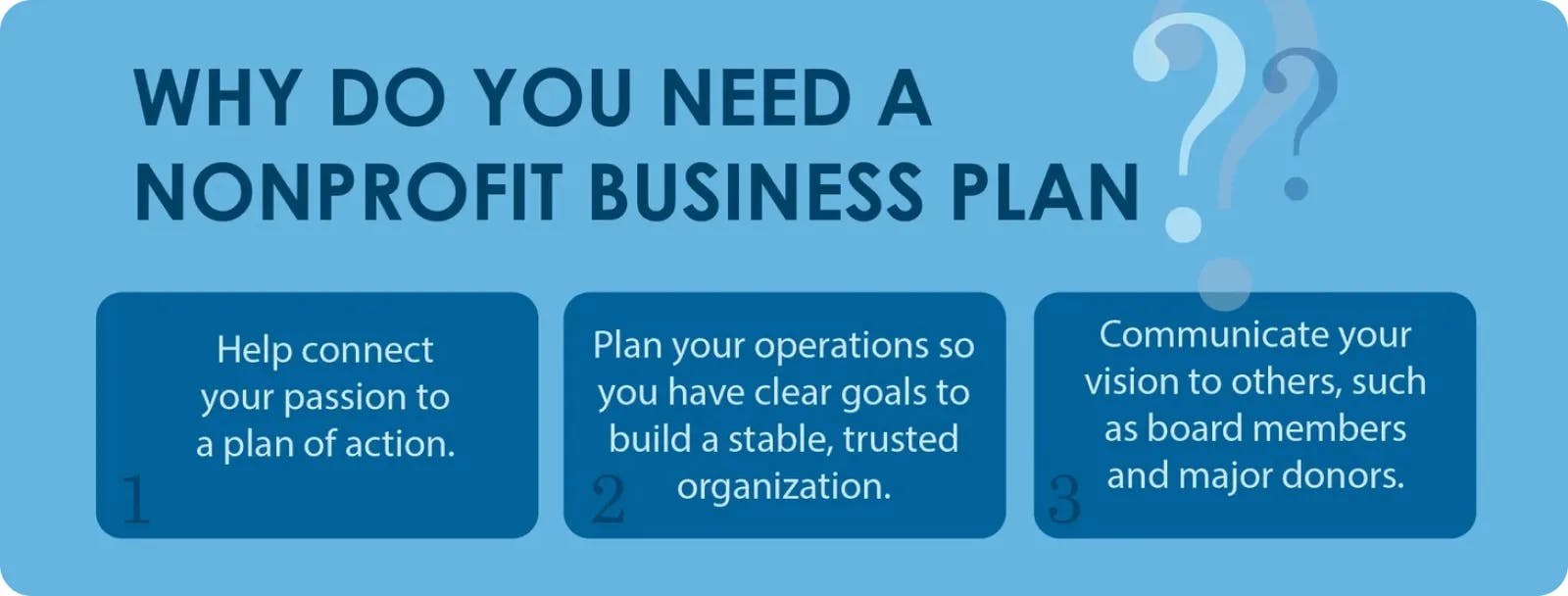Please note: This post contains affiliate links and we may receive a commission if you make a purchase using these links.
TABLE OF CONTENTS
Even though your organization doesn’t exist to make a profit, a nonprofit business plan can help you to define what you will do, how you’ll do it and what success looks like.
But it isn’t just an important internal document — you can use it to persuade donors, partner with other organizations and get a mandate to provide critical services. Creating an effective nonprofit business plan means asking and answering the right questions. That’s why we’ve put together this guide, sharing some of the essential areas and questions you can use to focus on making a real change.
How Do I Write a Business Plan for a Small Charity?
Bizee is here to help you with your nonprofit dreams. We have helpful guides on forming a nonprofit and the steps you need to follow. Read on to discover how a nonprofit business plan will help you help the world.
1. Define Your Nonprofit Mission and What You Do
A nonprofit provides benefits for a particular community, part of society or other group. Your nonprofit business plan should put this information front and center as part of your mission statement and reason for existing. To help you define exactly what your nonprofit will do, think about and answer the following areas:
- What is the main problem that your nonprofit will solve?
- How will your nonprofit solve this problem at a high level?
- What specific groups will your nonprofit support?
When you have an answer to each of these questions, develop them as a mission statement early in your business plan.
2. Describe Your Nonprofit and How It Fits into the Marketplace
You will need to describe key facts about your nonprofit, then demonstrate your research and show there’s a gap in the market for the area you’ve chosen. Some questions that will help you describe and contextualize your nonprofit include:
- What is the name of your nonprofit and where are the geographical areas where it operates?
- What are the key niches and areas where you will provide programs and services?
- Who are the main beneficiaries — individuals, groups or others — that you will target with your services?
- What is the legal status of your nonprofit, including its section 501(c)(3) designation?
- Do you have any competitors — nonprofits or regular businesses — providing similar services?
Ideally, you should provide as much market research, statistics and facts as possible to support the business case for your nonprofit’s existence.

3. Explain Your Key Programs and Services
A nonprofit offers its benefits through programs and services. The money that you collect from donors goes to fund these programs, and it’s the programs that provide positive outcomes for your beneficiaries.
These programs define the good works that your nonprofit does, and they demonstrate the approach you will take to make a change. Questions to help you explain your programs might include:
- What are the main programs and services that your nonprofit will provide?
- How does each of your programs support your overall mission statement?
- What specific problems does each of your programs help to solve?
- Who is the target group that each of your programs will benefit?
- How will you know if a program is successful?
Think of your programs as “how your nonprofit will meet its purpose” and spend some time and effort exploring each one.
4. Explain Who Your Main Donors and Partners Are
Nonprofits require regular donations to pay their operating costs and provide programs and services. You need to think carefully about who your donors and partners are, how you will approach them and why they would choose to support your nonprofit. Questions that will help you define your main donors include:
- Are you mainly targeting business, individual, community, government or other donors?
- How will you partner with other organizations and nonprofits?
- Have you developed donor personas for the groups you want to collect donations from?
- What are your expected targets for collecting donations from each donor source?
- Are you only seeking monetary donations, or will you accept contributions of products, services or similar?
- What incentives and publicity are you offering to donors that contribute to your nonprofit and how will you continue to connect with them?
5. Share Your Marketing Plan to Create Awareness and Get Donations
Marketing is just as important to a nonprofit as to a regular, for-profit business. Nonprofits use marketing plans for three main purposes:
- Raise awareness of your nonprofit, who it serves and what it does.
- Attract donors and encourage them to donate money, goods or services.
- Let your target groups know how you can help them.
As you’re sharing your marketing plan, think about and answer these questions:
- What does your market analysis tell you about the most efficient ways to communicate with donors and beneficiaries?
- What are the main channels that you will use for marketing — your website, local media, flyers and mailers, events or something else?
- What are the ideal outcomes that you will achieve as the result of effective marketing?
- How are you budgeting for your marketing activities?
- Are there any opportunities to get free marketing?
You will want to ask these questions for each of the three main marketing purposes we mentioned above. The way you market to and communicate with donors will probably be very different from your marketing channels for beneficiaries.
6. Show the Expertise of the People Running Your Nonprofit
A nonprofit heavily relies on the skills, experience and networks of the people involved in the organization. This doesn’t just apply to you and your day-to-day employees — nonprofits also have boards of people who make key decisions about your organization. Questions that will help you define your key people are:
- Who are the main employees of the organization and what are their roles and responsibilities?
- What is the overall organizational structure of the nonprofit?
- Who are the people that will be sitting on your board and what are their responsibilities?
- What are the top skills and experience of the main people involved with your nonprofit?
- How will you make operational and board-level decisions in the business and resolve possible disagreements?
7. Detail Your Financial Plan and Budget
Proper financial management is just as important to a nonprofit as for a regular business. You will need to detail exactly how you’re going to spend money on your operations and programs. Your financial plan should answer the following questions:
- How much money are you expecting to collect from donors?
- What are your operational costs, and what are the biggest contributors to those costs — staff salaries, location rental, marketing, etc.?
- What proportion of your donations will you put towards funding your nonprofit programs?
- Do your beneficiaries need to pay for any services and what does this do for your costs?
- What milestones and financial metrics will you measure?
- How will you report on and publish your donations and spending?
- What are the tax implications for your nonprofit, based on your status?
Your financial section should include your cash flow projects and a detailed budget of exactly how you’re going to collect and spend money.
8. Add in an Executive Summary at the Start of Your Nonprofit Business Plan
The executive summary is one of the first things you’ll present in your business plan, but it’s the last thing you’ll write. That’s because it highlights the key areas from the rest of your plan and presents everything in an easily digestible format at the top of the document.
There you have it — the key questions you will need to ask and answer to develop a strong nonprofit business plan. For a business plan template that you can adapt for your nonprofit, try out our free downloadable business plan worksheet.

Paul Maplesden
Paul is a freelance writer, small business owner, and British expat exploring the U.S. When he’s not politely apologizing, he enjoys hats, hockey, Earl Grey Tea, mountains, and dogs.
like what you’re reading?
Get Fresh Monthly Tips to Start & Grow Your LLC









